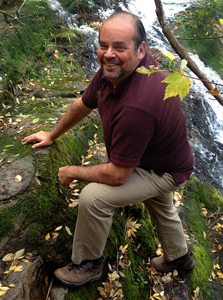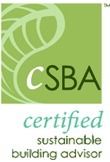LEEDing the Way to Green - A Green Architect's Perspective
The LEED (Leadership in Energy and Environmental Design) rating system was created as a way to document how buildings meet sustainability goals and promote them in the building industry. The construction industry is well-documented as the largest energy and water user and waste generator of any other industry on the planet. As an architect and sustainable building advisor, my goal, and that of Back to Terra, is to create responsible design that affects people and the environment in a positive way. I have practiced many sustainable concepts for over 23 years and am continually looking for ways to incorporate more of these ideas in ways that are economical and meaningful to my clients. Sustainability is a very important consideration in my design.
My interest in sustainability started before my formal college education and I continue to develop my knowledge in this focus area, which should, in my opinion, be part of every project and facet of life. Scientists have begun to realize that in order to survive as a species, humans need to be aware of, and truly live with, their environment. We must understand that the world is a giant closed ecosystem, and that damage to one part of the Earth can have an impact on other parts of the Earth. As a result, we need to work together to promote sustainability and minimize its impact on the globe. Sustainability is important from the neighborhood to the international level, and every citizen on Earth can contribute to the global effort to live more sustainable, healthy lives.
DKG Green Panel - "LEEDing the Way to Green" July 23, 2010
Introduction information for Chuck Crane:
"Chuck Crane is one of our Green Panelists today and started his formal sustainable studies at the School of Environmental Design at the University of Colorado and finished at Washington State University in Pullman, Washington. Chuck has a degree in Architecture and Architectural studies. He is involved in the American Institute of Architects Committee on the Environment and is an active member of the US Green Building Council. Chuck is the LEED User Group coordinator for the Inland Branch of Cascadia's Northwest Region, is a current Steering Committee Member and has served 2 years as a Co-Chair of this group in the past. He has worked as a Project Architect at Integrus Architecture for 8 years and is LEED Accredited as a LEED AP BD+C (Building Design and Construction)."
3 Questions for DKG Green Panel Presentation:
"What peaked your interest in becoming involved in Sustainable Design and LEED?"
"My grandmother has been my inspiration. She is 93 now and has always been interested in living off the land. She and my grandfather did for several years in Alaska. Leading up to that, she taught me about native cultures and we built a yurt in her backyard and camped out in it. She continues to feed me with books about the topic to this day. I continued to study sustainability at the School of Environmental Design at the University of Colorado, in Boulder and then on to WSU. I became more interested in sustainability through my early years in Architecture and took up the challenge, along with one of the Principals of our Seattle office in becoming the first to become LEED accredited in our Spokane office."
"What is the biggest challenge to overcome in a LEED project?"
"The biggest challenge we face is educating or motivating the client to incorporate sustainability in the buildings we design with them. We have been fortunate to have the majority of our clients come to us with a great enthusiasm to be sustainable, but there are a select few that we had to break into the thought more slowly and coach them along. In the end, I feel we have clients that will continue to build using a sustainable approach. The projects that are the most fun are those that the client is on board with great enthusiasm from the beginning. They understand the importance of sustainability and we share ideas freely and more readily explore the goals they are truly after."
"Are there things you would change about the LEED program?"
"I got involved in the LEED rating system pretty early on, testing under version 2.0. There was only version 1.0 before that and since then version 2.1, 2.2 and 3.0 was released midway through 2009. LEED is constantly improving, currently evolving into version 4. It is not perfect and there are a few LEED credits which, in my opinion, still need work, but the USGBC and GBCI do listen to the opinions of the users and have adjusted to make the system more seamless and more in tune with Architecture and Engineering. The switch to LEED online was a big improvement over a forest of paperwork, submitting eight pairs of three inch binders full of documentation for review of a LEED Silver project. Fortunately my first LEED project to document switched mid stream to the online version, so fewer trees have fallen to document the LEED process."
Currently I have been involved in 34 Sustainable Commercial Design Projects.
Work History:
Back to Terra Sustainable Architecture: Principal Architect, Nov 2012 to Present
BLRB Architects: Branch Manager, Aug 2015 to May 2017
RAFI Architecture: Promotion to Studio Director, June 2012 to Nov 2012
Integrus Architecture, PS: Promotion to Project Manager, June 2002 to July 2011
ALSC Architects: Promotion to Licensed Architect, March 1998 to May 2002
Tan Heyamoto Architects, Intern Architect, May 1990 to March 1998
WMFL Architects: Intern Architect, May 1989 to December 1989
> View Full PDF Resume <
.
The LEED (Leadership in Energy and Environmental Design) rating system was created as a way to document how buildings meet sustainability goals and promote them in the building industry. The construction industry is well-documented as the largest energy and water user and waste generator of any other industry on the planet. As an architect and sustainable building advisor, my goal, and that of Back to Terra, is to create responsible design that affects people and the environment in a positive way. I have practiced many sustainable concepts for over 23 years and am continually looking for ways to incorporate more of these ideas in ways that are economical and meaningful to my clients. Sustainability is a very important consideration in my design.
My interest in sustainability started before my formal college education and I continue to develop my knowledge in this focus area, which should, in my opinion, be part of every project and facet of life. Scientists have begun to realize that in order to survive as a species, humans need to be aware of, and truly live with, their environment. We must understand that the world is a giant closed ecosystem, and that damage to one part of the Earth can have an impact on other parts of the Earth. As a result, we need to work together to promote sustainability and minimize its impact on the globe. Sustainability is important from the neighborhood to the international level, and every citizen on Earth can contribute to the global effort to live more sustainable, healthy lives.
DKG Green Panel - "LEEDing the Way to Green" July 23, 2010
Introduction information for Chuck Crane:
"Chuck Crane is one of our Green Panelists today and started his formal sustainable studies at the School of Environmental Design at the University of Colorado and finished at Washington State University in Pullman, Washington. Chuck has a degree in Architecture and Architectural studies. He is involved in the American Institute of Architects Committee on the Environment and is an active member of the US Green Building Council. Chuck is the LEED User Group coordinator for the Inland Branch of Cascadia's Northwest Region, is a current Steering Committee Member and has served 2 years as a Co-Chair of this group in the past. He has worked as a Project Architect at Integrus Architecture for 8 years and is LEED Accredited as a LEED AP BD+C (Building Design and Construction)."
3 Questions for DKG Green Panel Presentation:
"What peaked your interest in becoming involved in Sustainable Design and LEED?"
"My grandmother has been my inspiration. She is 93 now and has always been interested in living off the land. She and my grandfather did for several years in Alaska. Leading up to that, she taught me about native cultures and we built a yurt in her backyard and camped out in it. She continues to feed me with books about the topic to this day. I continued to study sustainability at the School of Environmental Design at the University of Colorado, in Boulder and then on to WSU. I became more interested in sustainability through my early years in Architecture and took up the challenge, along with one of the Principals of our Seattle office in becoming the first to become LEED accredited in our Spokane office."
"What is the biggest challenge to overcome in a LEED project?"
"The biggest challenge we face is educating or motivating the client to incorporate sustainability in the buildings we design with them. We have been fortunate to have the majority of our clients come to us with a great enthusiasm to be sustainable, but there are a select few that we had to break into the thought more slowly and coach them along. In the end, I feel we have clients that will continue to build using a sustainable approach. The projects that are the most fun are those that the client is on board with great enthusiasm from the beginning. They understand the importance of sustainability and we share ideas freely and more readily explore the goals they are truly after."
"Are there things you would change about the LEED program?"
"I got involved in the LEED rating system pretty early on, testing under version 2.0. There was only version 1.0 before that and since then version 2.1, 2.2 and 3.0 was released midway through 2009. LEED is constantly improving, currently evolving into version 4. It is not perfect and there are a few LEED credits which, in my opinion, still need work, but the USGBC and GBCI do listen to the opinions of the users and have adjusted to make the system more seamless and more in tune with Architecture and Engineering. The switch to LEED online was a big improvement over a forest of paperwork, submitting eight pairs of three inch binders full of documentation for review of a LEED Silver project. Fortunately my first LEED project to document switched mid stream to the online version, so fewer trees have fallen to document the LEED process."
Currently I have been involved in 34 Sustainable Commercial Design Projects.
Work History:
Back to Terra Sustainable Architecture: Principal Architect, Nov 2012 to Present
BLRB Architects: Branch Manager, Aug 2015 to May 2017
RAFI Architecture: Promotion to Studio Director, June 2012 to Nov 2012
Integrus Architecture, PS: Promotion to Project Manager, June 2002 to July 2011
ALSC Architects: Promotion to Licensed Architect, March 1998 to May 2002
Tan Heyamoto Architects, Intern Architect, May 1990 to March 1998
WMFL Architects: Intern Architect, May 1989 to December 1989
> View Full PDF Resume <
.


Principal Architect, Washington, Idaho, Oregon "Mr. Green"
AIA, LEED AP BD+C, CSBA, NCARB
AIA, LEED AP BD+C, CSBA, NCARB







